Accounting of Managers: Budgeting and Costing Analysis
VerifiedAdded on 2019/11/20
|6
|1752
|155
Homework Assignment
AI Summary
This assignment delves into the core principles of accounting for managers, encompassing various aspects of financial analysis and decision-making. It starts by emphasizing the importance of flexible budgets in evaluating profit center performance, highlighting their adaptability to different operational levels and contrasting them with static budgets. The assignment then explores the components of cash budgets, illustrating their interrelation with sales, production, and purchases budgets in a manufacturing context. It further examines the operating and cash cycles, their respective elements, and their impact on working capital management. The assignment also addresses the role of accounting in government organizations and clarifies the significance of profit and financial reporting. It explores the objectives of costing systems, including cost reduction and control, and the allocation of overhead costs. The assignment provides practical calculations for overhead allocation rates, and the total costs of a project. It concludes by discussing the reasons for using budgeted overhead rates and the limitations of traditional overhead allocation methods, while proposing activity-based costing as an alternative.
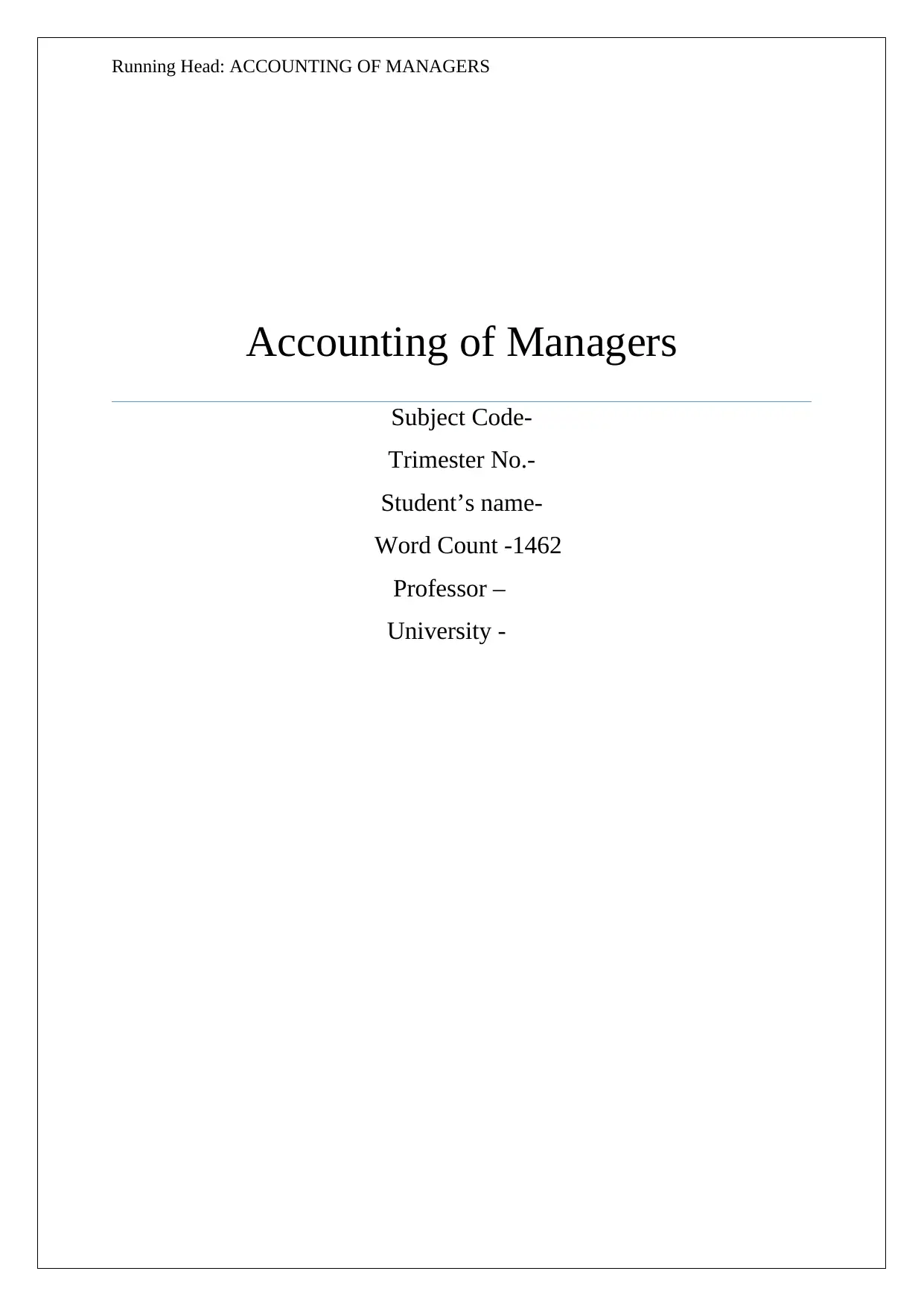
Running Head: ACCOUNTING OF MANAGERS
Accounting of Managers
Subject Code-
Trimester No.-
Student’s name-
Word Count -1462
Professor –
University -
Accounting of Managers
Subject Code-
Trimester No.-
Student’s name-
Word Count -1462
Professor –
University -
Paraphrase This Document
Need a fresh take? Get an instant paraphrase of this document with our AI Paraphraser
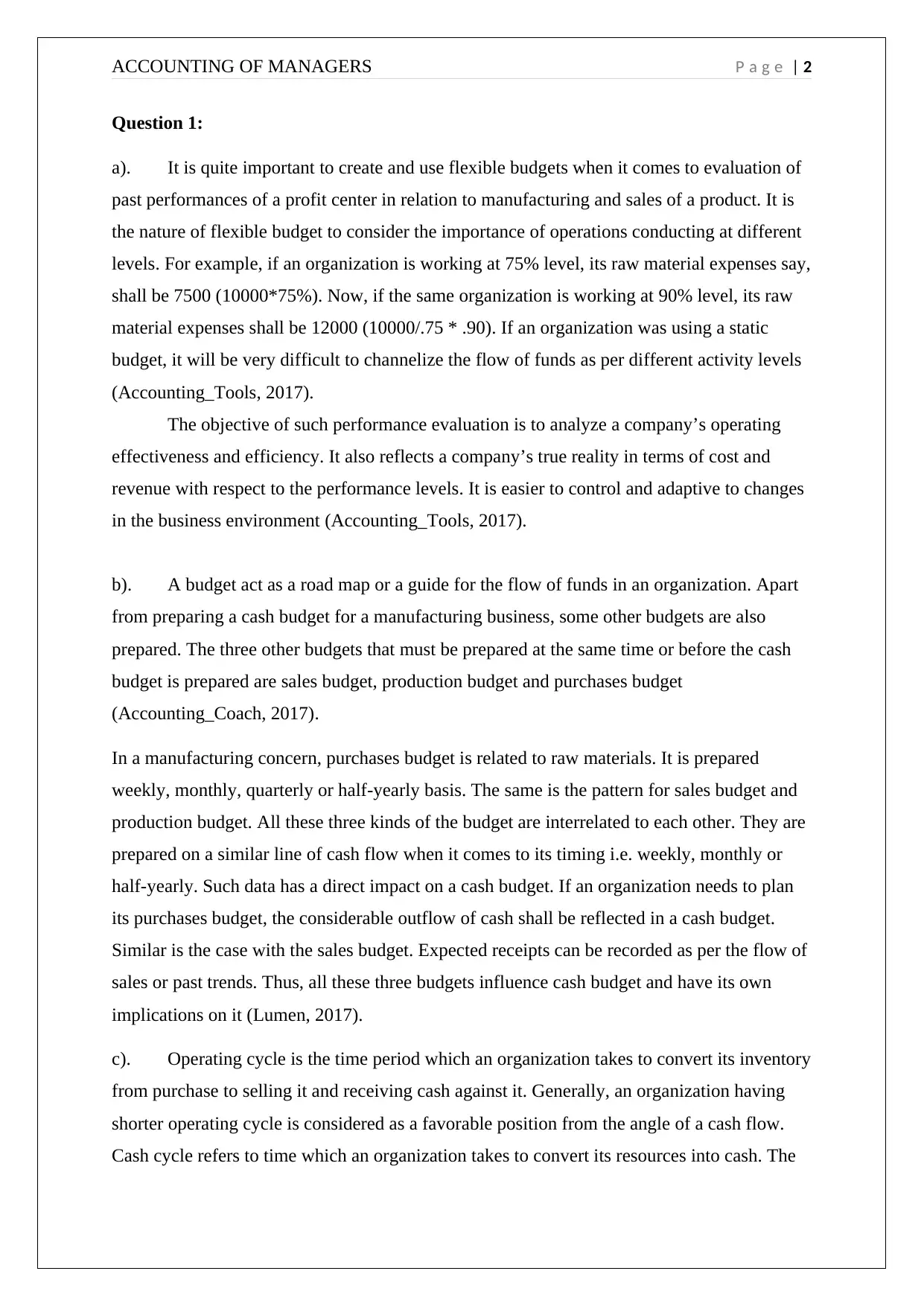
ACCOUNTING OF MANAGERS P a g e | 2
Question 1:
a). It is quite important to create and use flexible budgets when it comes to evaluation of
past performances of a profit center in relation to manufacturing and sales of a product. It is
the nature of flexible budget to consider the importance of operations conducting at different
levels. For example, if an organization is working at 75% level, its raw material expenses say,
shall be 7500 (10000*75%). Now, if the same organization is working at 90% level, its raw
material expenses shall be 12000 (10000/.75 * .90). If an organization was using a static
budget, it will be very difficult to channelize the flow of funds as per different activity levels
(Accounting_Tools, 2017).
The objective of such performance evaluation is to analyze a company’s operating
effectiveness and efficiency. It also reflects a company’s true reality in terms of cost and
revenue with respect to the performance levels. It is easier to control and adaptive to changes
in the business environment (Accounting_Tools, 2017).
b). A budget act as a road map or a guide for the flow of funds in an organization. Apart
from preparing a cash budget for a manufacturing business, some other budgets are also
prepared. The three other budgets that must be prepared at the same time or before the cash
budget is prepared are sales budget, production budget and purchases budget
(Accounting_Coach, 2017).
In a manufacturing concern, purchases budget is related to raw materials. It is prepared
weekly, monthly, quarterly or half-yearly basis. The same is the pattern for sales budget and
production budget. All these three kinds of the budget are interrelated to each other. They are
prepared on a similar line of cash flow when it comes to its timing i.e. weekly, monthly or
half-yearly. Such data has a direct impact on a cash budget. If an organization needs to plan
its purchases budget, the considerable outflow of cash shall be reflected in a cash budget.
Similar is the case with the sales budget. Expected receipts can be recorded as per the flow of
sales or past trends. Thus, all these three budgets influence cash budget and have its own
implications on it (Lumen, 2017).
c). Operating cycle is the time period which an organization takes to convert its inventory
from purchase to selling it and receiving cash against it. Generally, an organization having
shorter operating cycle is considered as a favorable position from the angle of a cash flow.
Cash cycle refers to time which an organization takes to convert its resources into cash. The
Question 1:
a). It is quite important to create and use flexible budgets when it comes to evaluation of
past performances of a profit center in relation to manufacturing and sales of a product. It is
the nature of flexible budget to consider the importance of operations conducting at different
levels. For example, if an organization is working at 75% level, its raw material expenses say,
shall be 7500 (10000*75%). Now, if the same organization is working at 90% level, its raw
material expenses shall be 12000 (10000/.75 * .90). If an organization was using a static
budget, it will be very difficult to channelize the flow of funds as per different activity levels
(Accounting_Tools, 2017).
The objective of such performance evaluation is to analyze a company’s operating
effectiveness and efficiency. It also reflects a company’s true reality in terms of cost and
revenue with respect to the performance levels. It is easier to control and adaptive to changes
in the business environment (Accounting_Tools, 2017).
b). A budget act as a road map or a guide for the flow of funds in an organization. Apart
from preparing a cash budget for a manufacturing business, some other budgets are also
prepared. The three other budgets that must be prepared at the same time or before the cash
budget is prepared are sales budget, production budget and purchases budget
(Accounting_Coach, 2017).
In a manufacturing concern, purchases budget is related to raw materials. It is prepared
weekly, monthly, quarterly or half-yearly basis. The same is the pattern for sales budget and
production budget. All these three kinds of the budget are interrelated to each other. They are
prepared on a similar line of cash flow when it comes to its timing i.e. weekly, monthly or
half-yearly. Such data has a direct impact on a cash budget. If an organization needs to plan
its purchases budget, the considerable outflow of cash shall be reflected in a cash budget.
Similar is the case with the sales budget. Expected receipts can be recorded as per the flow of
sales or past trends. Thus, all these three budgets influence cash budget and have its own
implications on it (Lumen, 2017).
c). Operating cycle is the time period which an organization takes to convert its inventory
from purchase to selling it and receiving cash against it. Generally, an organization having
shorter operating cycle is considered as a favorable position from the angle of a cash flow.
Cash cycle refers to time which an organization takes to convert its resources into cash. The
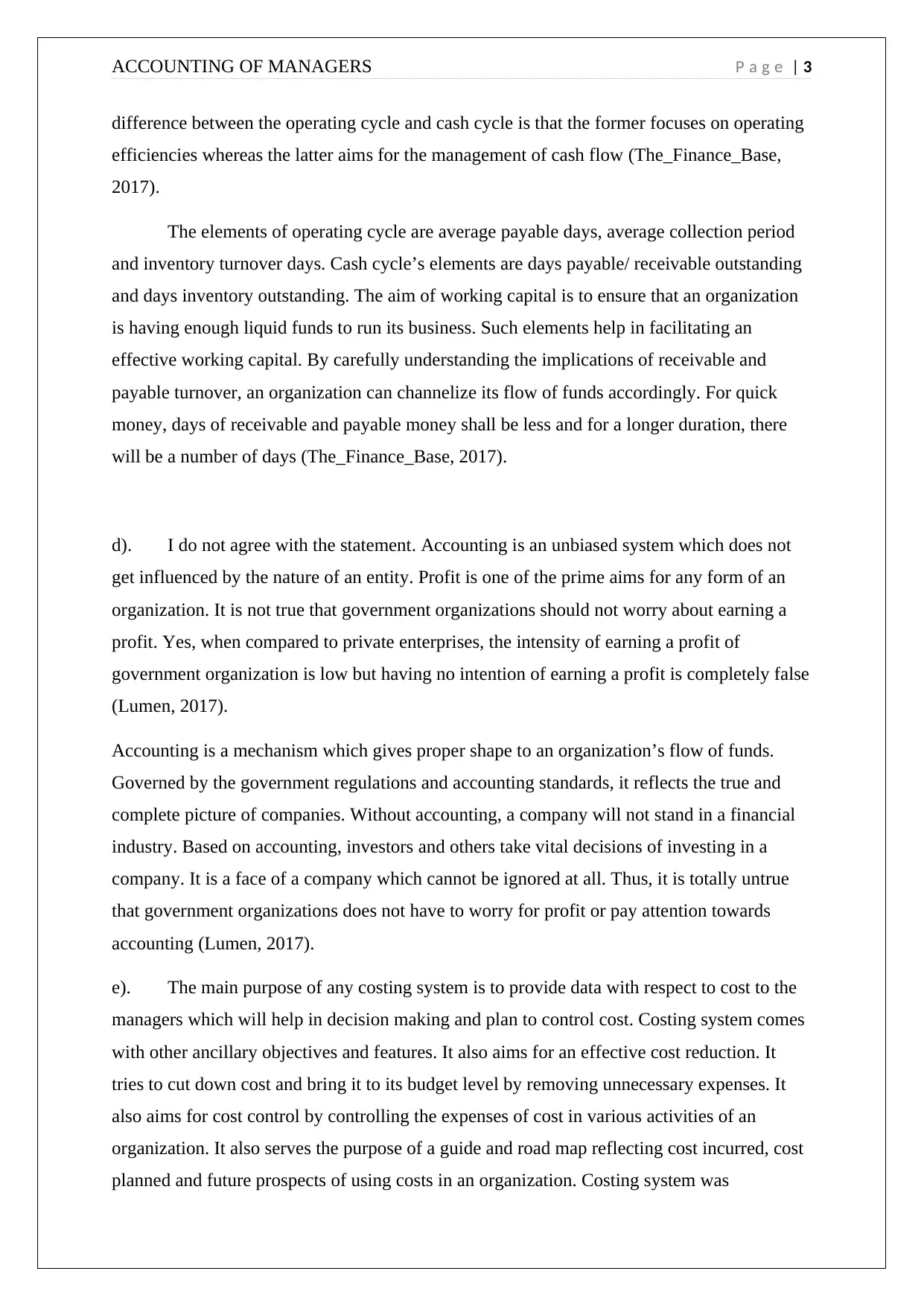
ACCOUNTING OF MANAGERS P a g e | 3
difference between the operating cycle and cash cycle is that the former focuses on operating
efficiencies whereas the latter aims for the management of cash flow (The_Finance_Base,
2017).
The elements of operating cycle are average payable days, average collection period
and inventory turnover days. Cash cycle’s elements are days payable/ receivable outstanding
and days inventory outstanding. The aim of working capital is to ensure that an organization
is having enough liquid funds to run its business. Such elements help in facilitating an
effective working capital. By carefully understanding the implications of receivable and
payable turnover, an organization can channelize its flow of funds accordingly. For quick
money, days of receivable and payable money shall be less and for a longer duration, there
will be a number of days (The_Finance_Base, 2017).
d). I do not agree with the statement. Accounting is an unbiased system which does not
get influenced by the nature of an entity. Profit is one of the prime aims for any form of an
organization. It is not true that government organizations should not worry about earning a
profit. Yes, when compared to private enterprises, the intensity of earning a profit of
government organization is low but having no intention of earning a profit is completely false
(Lumen, 2017).
Accounting is a mechanism which gives proper shape to an organization’s flow of funds.
Governed by the government regulations and accounting standards, it reflects the true and
complete picture of companies. Without accounting, a company will not stand in a financial
industry. Based on accounting, investors and others take vital decisions of investing in a
company. It is a face of a company which cannot be ignored at all. Thus, it is totally untrue
that government organizations does not have to worry for profit or pay attention towards
accounting (Lumen, 2017).
e). The main purpose of any costing system is to provide data with respect to cost to the
managers which will help in decision making and plan to control cost. Costing system comes
with other ancillary objectives and features. It also aims for an effective cost reduction. It
tries to cut down cost and bring it to its budget level by removing unnecessary expenses. It
also aims for cost control by controlling the expenses of cost in various activities of an
organization. It also serves the purpose of a guide and road map reflecting cost incurred, cost
planned and future prospects of using costs in an organization. Costing system was
difference between the operating cycle and cash cycle is that the former focuses on operating
efficiencies whereas the latter aims for the management of cash flow (The_Finance_Base,
2017).
The elements of operating cycle are average payable days, average collection period
and inventory turnover days. Cash cycle’s elements are days payable/ receivable outstanding
and days inventory outstanding. The aim of working capital is to ensure that an organization
is having enough liquid funds to run its business. Such elements help in facilitating an
effective working capital. By carefully understanding the implications of receivable and
payable turnover, an organization can channelize its flow of funds accordingly. For quick
money, days of receivable and payable money shall be less and for a longer duration, there
will be a number of days (The_Finance_Base, 2017).
d). I do not agree with the statement. Accounting is an unbiased system which does not
get influenced by the nature of an entity. Profit is one of the prime aims for any form of an
organization. It is not true that government organizations should not worry about earning a
profit. Yes, when compared to private enterprises, the intensity of earning a profit of
government organization is low but having no intention of earning a profit is completely false
(Lumen, 2017).
Accounting is a mechanism which gives proper shape to an organization’s flow of funds.
Governed by the government regulations and accounting standards, it reflects the true and
complete picture of companies. Without accounting, a company will not stand in a financial
industry. Based on accounting, investors and others take vital decisions of investing in a
company. It is a face of a company which cannot be ignored at all. Thus, it is totally untrue
that government organizations does not have to worry for profit or pay attention towards
accounting (Lumen, 2017).
e). The main purpose of any costing system is to provide data with respect to cost to the
managers which will help in decision making and plan to control cost. Costing system comes
with other ancillary objectives and features. It also aims for an effective cost reduction. It
tries to cut down cost and bring it to its budget level by removing unnecessary expenses. It
also aims for cost control by controlling the expenses of cost in various activities of an
organization. It also serves the purpose of a guide and road map reflecting cost incurred, cost
planned and future prospects of using costs in an organization. Costing system was
⊘ This is a preview!⊘
Do you want full access?
Subscribe today to unlock all pages.

Trusted by 1+ million students worldwide
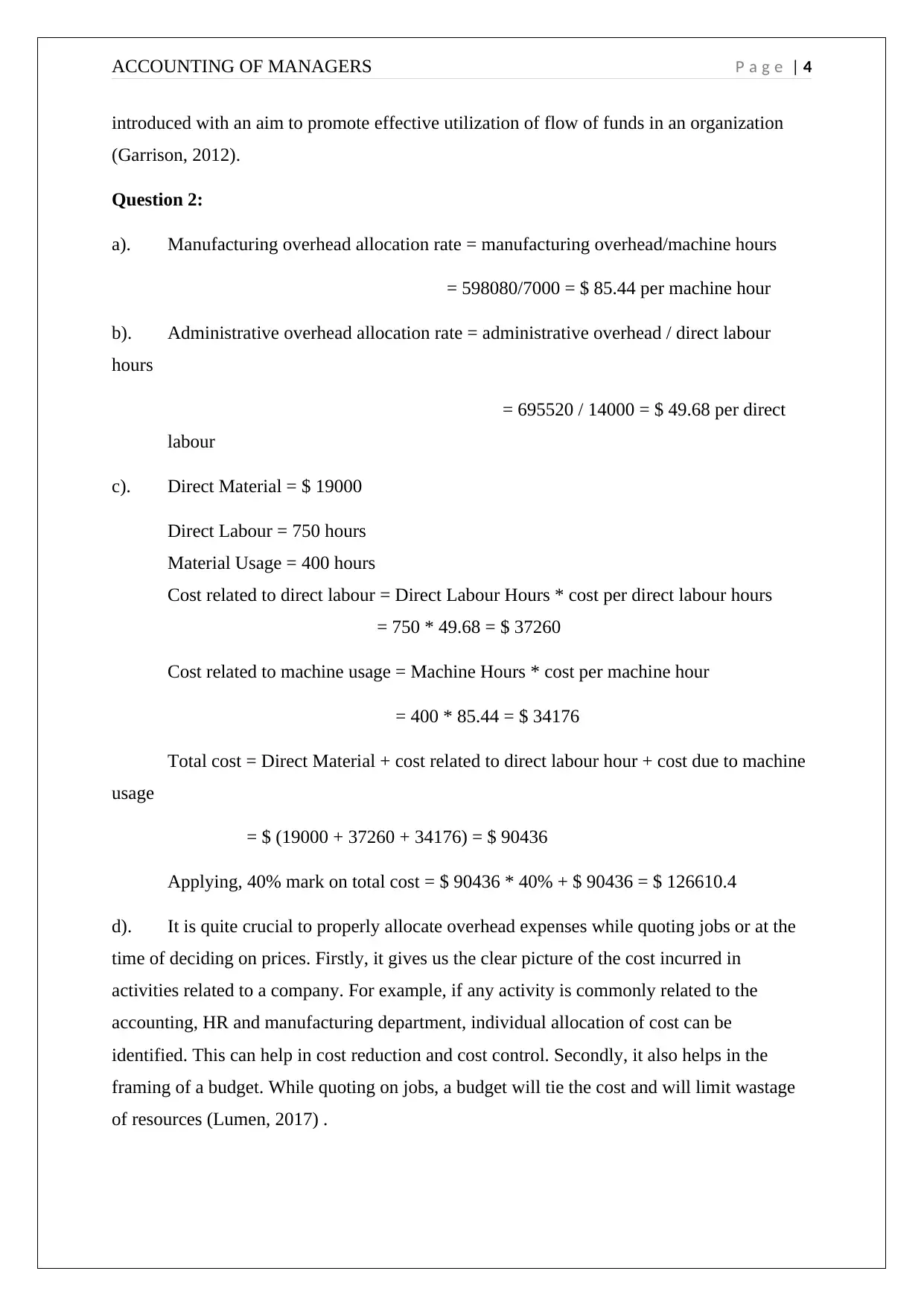
ACCOUNTING OF MANAGERS P a g e | 4
introduced with an aim to promote effective utilization of flow of funds in an organization
(Garrison, 2012).
Question 2:
a). Manufacturing overhead allocation rate = manufacturing overhead/machine hours
= 598080/7000 = $ 85.44 per machine hour
b). Administrative overhead allocation rate = administrative overhead / direct labour
hours
= 695520 / 14000 = $ 49.68 per direct
labour
c). Direct Material = $ 19000
Direct Labour = 750 hours
Material Usage = 400 hours
Cost related to direct labour = Direct Labour Hours * cost per direct labour hours
= 750 * 49.68 = $ 37260
Cost related to machine usage = Machine Hours * cost per machine hour
= 400 * 85.44 = $ 34176
Total cost = Direct Material + cost related to direct labour hour + cost due to machine
usage
= $ (19000 + 37260 + 34176) = $ 90436
Applying, 40% mark on total cost = $ 90436 * 40% + $ 90436 = $ 126610.4
d). It is quite crucial to properly allocate overhead expenses while quoting jobs or at the
time of deciding on prices. Firstly, it gives us the clear picture of the cost incurred in
activities related to a company. For example, if any activity is commonly related to the
accounting, HR and manufacturing department, individual allocation of cost can be
identified. This can help in cost reduction and cost control. Secondly, it also helps in the
framing of a budget. While quoting on jobs, a budget will tie the cost and will limit wastage
of resources (Lumen, 2017) .
introduced with an aim to promote effective utilization of flow of funds in an organization
(Garrison, 2012).
Question 2:
a). Manufacturing overhead allocation rate = manufacturing overhead/machine hours
= 598080/7000 = $ 85.44 per machine hour
b). Administrative overhead allocation rate = administrative overhead / direct labour
hours
= 695520 / 14000 = $ 49.68 per direct
labour
c). Direct Material = $ 19000
Direct Labour = 750 hours
Material Usage = 400 hours
Cost related to direct labour = Direct Labour Hours * cost per direct labour hours
= 750 * 49.68 = $ 37260
Cost related to machine usage = Machine Hours * cost per machine hour
= 400 * 85.44 = $ 34176
Total cost = Direct Material + cost related to direct labour hour + cost due to machine
usage
= $ (19000 + 37260 + 34176) = $ 90436
Applying, 40% mark on total cost = $ 90436 * 40% + $ 90436 = $ 126610.4
d). It is quite crucial to properly allocate overhead expenses while quoting jobs or at the
time of deciding on prices. Firstly, it gives us the clear picture of the cost incurred in
activities related to a company. For example, if any activity is commonly related to the
accounting, HR and manufacturing department, individual allocation of cost can be
identified. This can help in cost reduction and cost control. Secondly, it also helps in the
framing of a budget. While quoting on jobs, a budget will tie the cost and will limit wastage
of resources (Lumen, 2017) .
Paraphrase This Document
Need a fresh take? Get an instant paraphrase of this document with our AI Paraphraser
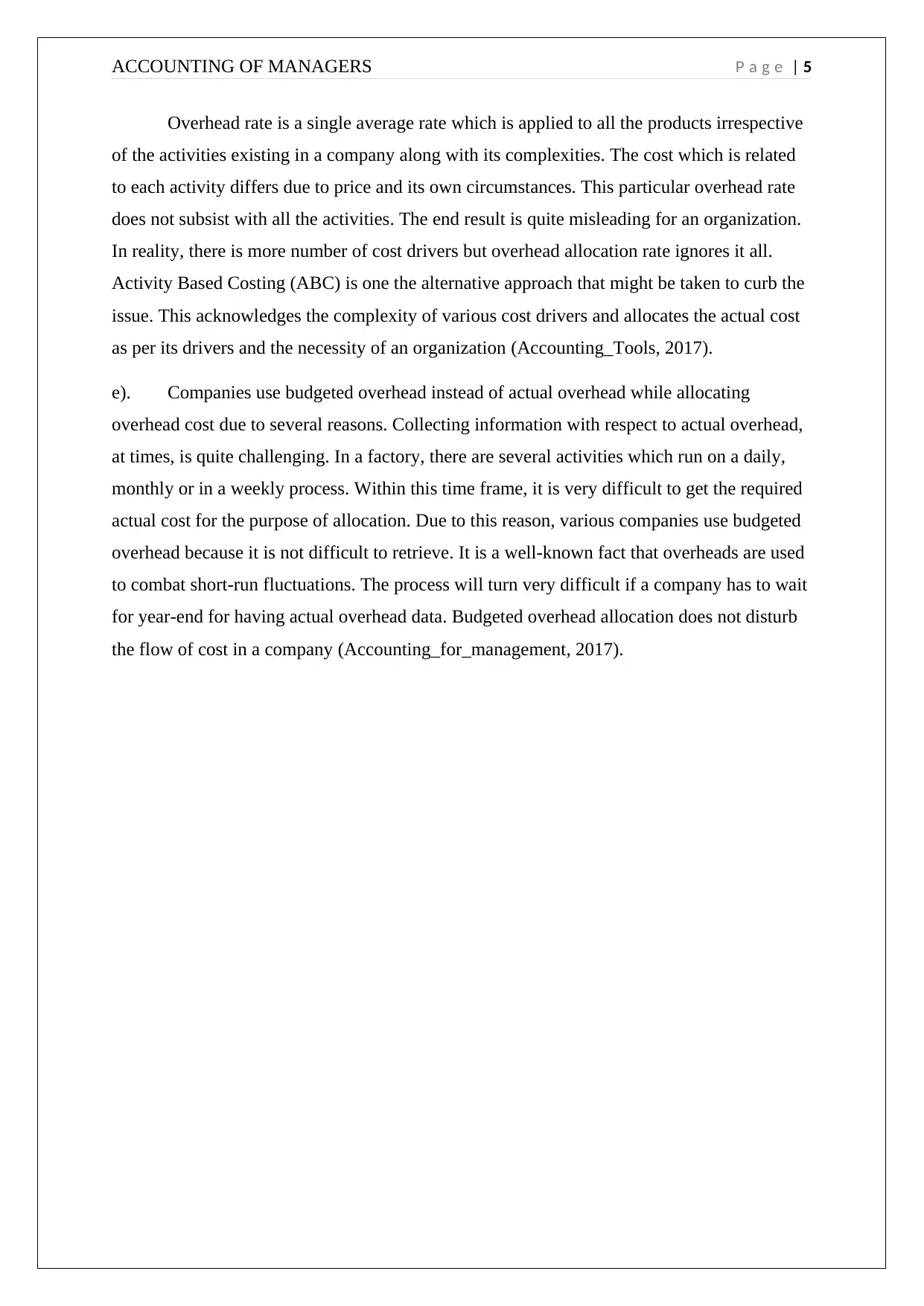
ACCOUNTING OF MANAGERS P a g e | 5
Overhead rate is a single average rate which is applied to all the products irrespective
of the activities existing in a company along with its complexities. The cost which is related
to each activity differs due to price and its own circumstances. This particular overhead rate
does not subsist with all the activities. The end result is quite misleading for an organization.
In reality, there is more number of cost drivers but overhead allocation rate ignores it all.
Activity Based Costing (ABC) is one the alternative approach that might be taken to curb the
issue. This acknowledges the complexity of various cost drivers and allocates the actual cost
as per its drivers and the necessity of an organization (Accounting_Tools, 2017).
e). Companies use budgeted overhead instead of actual overhead while allocating
overhead cost due to several reasons. Collecting information with respect to actual overhead,
at times, is quite challenging. In a factory, there are several activities which run on a daily,
monthly or in a weekly process. Within this time frame, it is very difficult to get the required
actual cost for the purpose of allocation. Due to this reason, various companies use budgeted
overhead because it is not difficult to retrieve. It is a well-known fact that overheads are used
to combat short-run fluctuations. The process will turn very difficult if a company has to wait
for year-end for having actual overhead data. Budgeted overhead allocation does not disturb
the flow of cost in a company (Accounting_for_management, 2017).
Overhead rate is a single average rate which is applied to all the products irrespective
of the activities existing in a company along with its complexities. The cost which is related
to each activity differs due to price and its own circumstances. This particular overhead rate
does not subsist with all the activities. The end result is quite misleading for an organization.
In reality, there is more number of cost drivers but overhead allocation rate ignores it all.
Activity Based Costing (ABC) is one the alternative approach that might be taken to curb the
issue. This acknowledges the complexity of various cost drivers and allocates the actual cost
as per its drivers and the necessity of an organization (Accounting_Tools, 2017).
e). Companies use budgeted overhead instead of actual overhead while allocating
overhead cost due to several reasons. Collecting information with respect to actual overhead,
at times, is quite challenging. In a factory, there are several activities which run on a daily,
monthly or in a weekly process. Within this time frame, it is very difficult to get the required
actual cost for the purpose of allocation. Due to this reason, various companies use budgeted
overhead because it is not difficult to retrieve. It is a well-known fact that overheads are used
to combat short-run fluctuations. The process will turn very difficult if a company has to wait
for year-end for having actual overhead data. Budgeted overhead allocation does not disturb
the flow of cost in a company (Accounting_for_management, 2017).
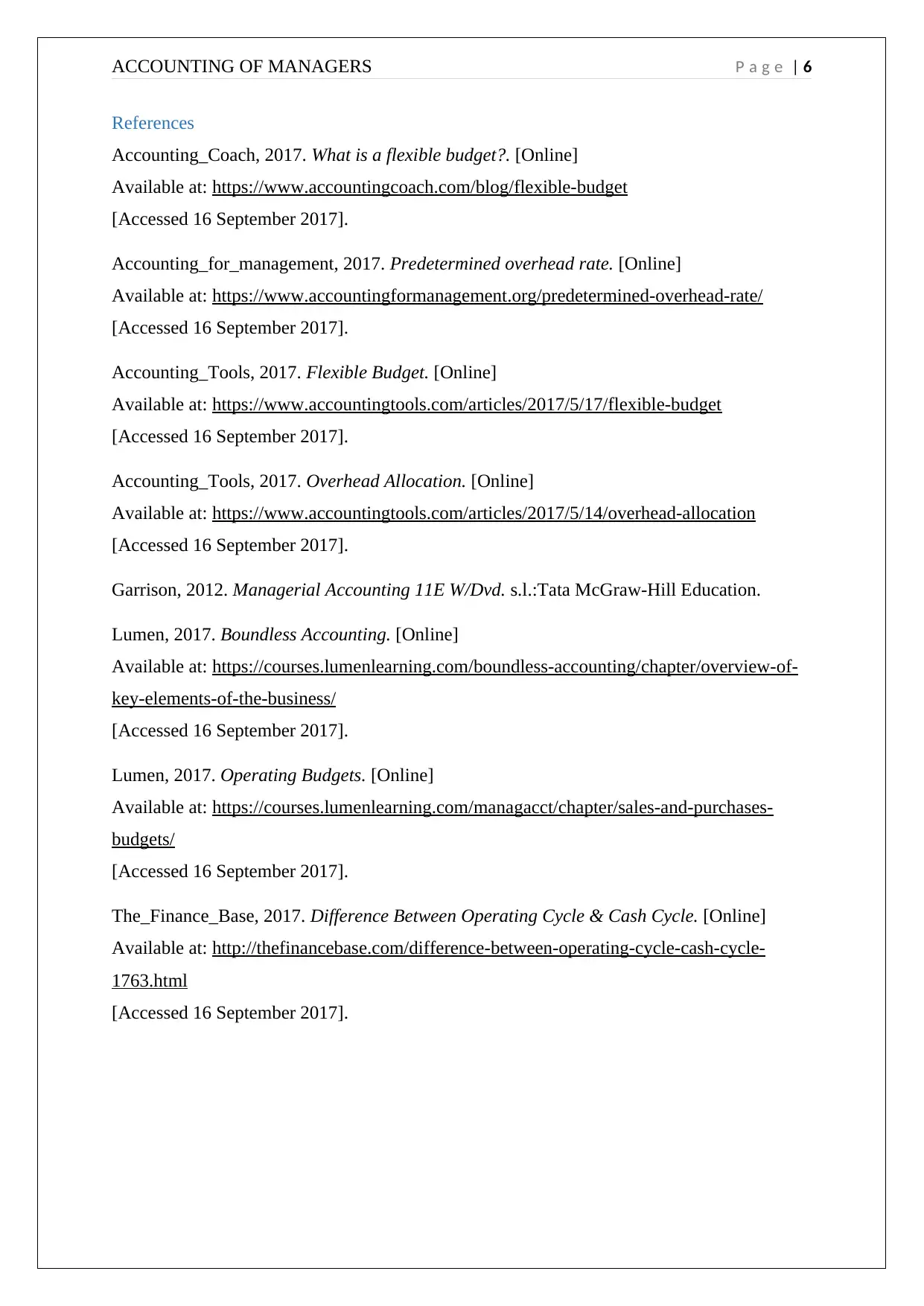
ACCOUNTING OF MANAGERS P a g e | 6
References
Accounting_Coach, 2017. What is a flexible budget?. [Online]
Available at: https://www.accountingcoach.com/blog/flexible-budget
[Accessed 16 September 2017].
Accounting_for_management, 2017. Predetermined overhead rate. [Online]
Available at: https://www.accountingformanagement.org/predetermined-overhead-rate/
[Accessed 16 September 2017].
Accounting_Tools, 2017. Flexible Budget. [Online]
Available at: https://www.accountingtools.com/articles/2017/5/17/flexible-budget
[Accessed 16 September 2017].
Accounting_Tools, 2017. Overhead Allocation. [Online]
Available at: https://www.accountingtools.com/articles/2017/5/14/overhead-allocation
[Accessed 16 September 2017].
Garrison, 2012. Managerial Accounting 11E W/Dvd. s.l.:Tata McGraw-Hill Education.
Lumen, 2017. Boundless Accounting. [Online]
Available at: https://courses.lumenlearning.com/boundless-accounting/chapter/overview-of-
key-elements-of-the-business/
[Accessed 16 September 2017].
Lumen, 2017. Operating Budgets. [Online]
Available at: https://courses.lumenlearning.com/managacct/chapter/sales-and-purchases-
budgets/
[Accessed 16 September 2017].
The_Finance_Base, 2017. Difference Between Operating Cycle & Cash Cycle. [Online]
Available at: http://thefinancebase.com/difference-between-operating-cycle-cash-cycle-
1763.html
[Accessed 16 September 2017].
References
Accounting_Coach, 2017. What is a flexible budget?. [Online]
Available at: https://www.accountingcoach.com/blog/flexible-budget
[Accessed 16 September 2017].
Accounting_for_management, 2017. Predetermined overhead rate. [Online]
Available at: https://www.accountingformanagement.org/predetermined-overhead-rate/
[Accessed 16 September 2017].
Accounting_Tools, 2017. Flexible Budget. [Online]
Available at: https://www.accountingtools.com/articles/2017/5/17/flexible-budget
[Accessed 16 September 2017].
Accounting_Tools, 2017. Overhead Allocation. [Online]
Available at: https://www.accountingtools.com/articles/2017/5/14/overhead-allocation
[Accessed 16 September 2017].
Garrison, 2012. Managerial Accounting 11E W/Dvd. s.l.:Tata McGraw-Hill Education.
Lumen, 2017. Boundless Accounting. [Online]
Available at: https://courses.lumenlearning.com/boundless-accounting/chapter/overview-of-
key-elements-of-the-business/
[Accessed 16 September 2017].
Lumen, 2017. Operating Budgets. [Online]
Available at: https://courses.lumenlearning.com/managacct/chapter/sales-and-purchases-
budgets/
[Accessed 16 September 2017].
The_Finance_Base, 2017. Difference Between Operating Cycle & Cash Cycle. [Online]
Available at: http://thefinancebase.com/difference-between-operating-cycle-cash-cycle-
1763.html
[Accessed 16 September 2017].
⊘ This is a preview!⊘
Do you want full access?
Subscribe today to unlock all pages.

Trusted by 1+ million students worldwide
1 out of 6
Related Documents
Your All-in-One AI-Powered Toolkit for Academic Success.
+13062052269
info@desklib.com
Available 24*7 on WhatsApp / Email
![[object Object]](/_next/static/media/star-bottom.7253800d.svg)
Unlock your academic potential
Copyright © 2020–2025 A2Z Services. All Rights Reserved. Developed and managed by ZUCOL.





